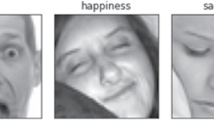Abstract
Facial expression classification aims to recognize human emotion via face images. The major challenge of facial expression classification is how to extract discriminative features from the human face images to differentiate various emotions. To tackle this challenge, a new feature extraction approach is proposed in this paper. The proposed approach defines a new set of salient patterns at the facial keypoint locations. This is in contrast to conventional approaches that either represent the whole face image as a regular grid or use local image patches centered at all facial key point locations. Driven by the proposed salient patterns, both the geometric and textual features are extracted and then concatenated and further incorporated into a machine learning framework to perform facial expression classification. The proposed approach is evaluated in the well-known CK + benchmark dataset to demonstrate its superior performance.




Similar content being viewed by others
References
Acevedo D, Negri P, Buemi ME, Fernández FG, Mejail M (2017) A simple geometric-based descriptor for facial expression recognition. In: IEEE Int Conf on automatic face gesture recognition, pp 802– 808
Chang C-C, Lin C-J (2011) LIBSVM: A library for support vector machines. ACM Trans Intell Syst Technol 2(3):1–17
Datta S, Sen D, Balasubramanian R (2017) Integrating geometric and textural features for facial emotion classification using SVM frameworks. In: Int Conf on computer vision and image processing, Singapore, pp 619–628
Deshmukh S, Patwardhan M, Mahajan A (2016) Survey on real-time facial expression recognition techniques. IET Biom 5(3):155–163
Fernandes JA, Matos LN, Aragao MGS (2016) Geometrical approaches for facial expression recognition using support vector machines. In: Int Conf on graphics, patterns and images Sao Paulo, Brazil, pp 347–354
Ghimire D, Jeong S, Lee J, Park SH (2017) Facial expression recognition based on local region specific features and support vector machines. Multimedia Tools and Applications 76(6):7803–7821
Ghimire D, Lee J, Li Z-N, Jeong S (2017) Recognition of facial expressions based on salient geometric features and support vector machines. Multimedia Tools and Applications 76(6):7921–7946
Happy SL, Routray A (2015) Automatic facial expression recognition using features of salient facial patches. IEEE Trans Affect Comput 6(1):1–12
Huang D, Shan C, Ardabilian M, Wang Y, Chen L (2011) Local binary patterns and its application to facial image analysis: A survey. IEEE Trans Syst Man Cybern Part C Appl Rev 41(6):765– 781
Hsieh C-C, Hsih M-H, Jiang M-K, Cheng Y-M, Liang E-H (2016) Effective semantic features for facial expressions recognition using SVM. Multimedia Tools and Applications 75(11):6663–6682
Jain S, Hu C, Aggarwal JK (2011) Facial expression recognition with temporal modeling of shapes. In: IEEE Int Conf on computer vision workshops, pp 1642–1649
Kim B-K, Roh J, Dong S-Y, Lee S-Y (2016) Hierarchical committee of deep convolutional neural networks for robust facial expression recognition. Journal on Multimodal User Interfaces 2:173– 189
King DE (2009) Dlib-ml: a machine learning toolkit. J Mach Learn Res 10:1755–1758
Kotsia I, Pitas I (2007) Facial expression recognition in image sequences using geometric deformation features and support vector machines. IEEE Trans Image Process 16(1):172–187
Liu C, Wechsler H (2002) Gabor feature based classification using the enhanced fisher linear discriminant model for face recognition. IEEE Trans Image Process 11(4):467–476
Liu M, Li S, Shan S, Wang R, Chen X (2015) Deeply learning deformable facial action parts model for dynamic expression analysis. In: Asian Conf on computer vision, Singapore, pp 143–157
Lucey P, Cohn JF, Kanade T, Saragih J, Ambadar Z, Matthews I (2010) The extended cohn-kanade dataset (CK + ): A complete dataset for action unit and emotion-specified expression. In: IEEE Int. Conf. on computer vision and pattern recognition, San Francisco, pp 94–101
Lyons MJ, Budynek J, Akamatsu S (1999) Automatic classification of single facial images. IEEE Trans Pattern Ana Mach Intell 21(12):1357–1362
Majumder A, Behera L, Subramanian V (2018) Automatic facial expression recognition system using deep network-based data fusion. IEEE Trans on Cybernetics 28(1):103–114
Martinez B, Valstar MF, Jiang B, Pantic M (2017) Automatic analysis of facial actions: A survey. IEEE Trans. on Affective Computing. accepted
Ojala T, Pietikainen M, Maenpaa T (2002) Multiresolution gray-scale and rotation invariant texture classification with local binary patterns. IEEE Trans Pattern Anal Mach Intell 24(7):971–987
Sariyanidi E, Gunes H, Cavallaro A (2015) Automatic analysis of facial affect: a survey of registration, representation, and recognition. IEEE Trans Pattern Anal Mach Intell 37(6):1113–1133
Siddiqi MH, Ali M, Abdelrahman ME, Khan A, Banos O, Khan AM, Lee S, Choo H (2018) Evaluating real-life performance of the state-of-the-art in facial expression recognition using a novel YouTube-based datasets. Multimedia Tools and Applications 77(1):917–937
Takalkar M, Xu M, Wu Q, Chaczko Z (2017) A survey: Facial micro-expression recognition. Multimedia Tools and Applications :1–25. accepted
Yang B, Cao J-M, Jiang D-P, Lv J-D (2017) Facial expression recognition based on dual-feature fusion and improved random forest classifier. Multimedia Tools and Applications :1–23. accepted
Yu J, Wang Z (2017) A video-based facial motion tracking and expression recognition system. Multimedia Tools and Applications 76(13):14,653–14,672
Zhang Z, Luo P, Loy CC, Tang X (2014) Facial landmark detection by deep multi-task learning. In: European Conf on computer vision, Zurich, Switzerland, pp 94–108
Author information
Authors and Affiliations
Corresponding author
Rights and permissions
About this article
Cite this article
Li, R., Tian, J. & Chua, M.C.H. Facial expression classification using salient pattern driven integrated geometric and textual features. Multimed Tools Appl 78, 28971–28983 (2019). https://doi.org/10.1007/s11042-018-6133-z
Received:
Revised:
Accepted:
Published:
Issue Date:
DOI: https://doi.org/10.1007/s11042-018-6133-z




